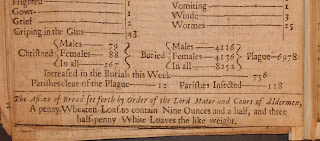 We were lucky enough to acquire a kind of miraculous survival of the Great Plague: ten of the weekly death tallies issued in London during 1665 as the plague ravaged the city. They list all deaths within the city and their causes. Turning from one week to the next, you can watch the classic epidemic curve play out in hard numbers as they were presented at the time.
We were lucky enough to acquire a kind of miraculous survival of the Great Plague: ten of the weekly death tallies issued in London during 1665 as the plague ravaged the city. They list all deaths within the city and their causes. Turning from one week to the next, you can watch the classic epidemic curve play out in hard numbers as they were presented at the time. The listing is harrowing--from 2,012 plague deaths the week of July 25th, to 6,978 death during the last week of August. When you factor in how many people lied to avoid quarantine, the total death toll is staggering. At the bottom of each weekly list, looking almost like an advertisement, there is a note on the price of bread dictated by the Lord Mayor. Imagine what the scene must have been as the epidemic spread and an increasingly proportion of the city's inhabitants fell ill or died. Basic services broke down. The Lord Mayor's assize of bread was an attempt to regulate the price of a basic human need that was becoming scare in nightmarish cityscape where price gouging threatened the already suffering populous. A penny bought a nine and a half ounce wheaten loaf; white loaves cost an additional half penny.
These broadsides give an immediacy to books like Defoe's Diary of a Plague Year published over fifty years later. To see them, ask for Rare HB1416.L8 D5.


